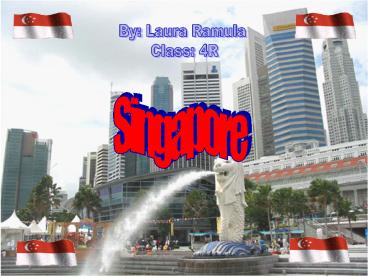Singapore - PowerPoint PPT Presentation
1 / 8
Title:
Singapore
Description:
Singapore Airlines began with the incorporation of Malayan Airways ... The airline's first flight was a chartered flight from the ... Singapore Airlines ... – PowerPoint PPT presentation
Number of Views:269
Avg rating:3.0/5.0
Title: Singapore
1
By Laura Ramula Class 4R
Singapore
2
Contence
- Interesting Facts pg1
- Map pg2
- Captions pg3
- Capital Tower pg4
- Singapore Airlines pg5
- Singapore Flag pg6
3
Interesting Facts
Singapore at world war II
Where is Singapore?
When Japan took over Singapore in World War II,
Winston Churchill had called it "Britain's
greatest defeat". In 1963, it merged with Malaya,
Sabah and Sarawak to form Malaysia. Even though
Singapore later reverted to British rule in 1945,
in less than two years, it split from the
federation and became an independent republic on
9 August 1965. This was the same year when
Singapore joined the United Nations on September
21.
Singapore is an island nation located at the
southern tip of the Malay Peninsula. It lies 137
kilometers (85 mi) north of the Equator, south of
the Malaysian state of Johor and north of
Indonesia's Riau Islands. At 704.0 km² (272 sq
mi), it is one of the few remaining city-states
in the world and the smallest country in
Southeast Asia.
1
4
Map of Singapore
Northern islands
Western islands
Southern islands
Did you know that the capital city of Singapore
is Singapore
2
5
Captions
Capital tower of Singapore
Der Sri Mariamman Temple Singapore
The flag of Singapore
3
6
Capital Tower
The Capital Tower is the fourth tallest
skyscraper in the city of Singapore, reaching a
height of 254 meters. Formally planned as the
POSBank's headquarters building, it was
transferred to the ownership of Capita Land. It
became the company's flagship building and was
then named after the company. Since the
completion of the building in 2000, Capital Tower
graces the Singapore skyline as the fourth
tallest skyscraper, and the tallest building in
the Shenton Way-Tanjong Pagar financial district.
4
7
Singapore Airlines
Singapore Airlines began with the incorporation
of Malayan Airways Limited (MAL) on 12 October
1947, by the Ocean Steamship Company of
Liverpool, the Straits Steamship Company of
Singapore and Imperial Airways. The airline's
first flight was a chartered flight from the
British Straits Settlement of Singapore to Kuala
Lumpur on 2 April 1947 using an Airspeed Consul
twin-engine airplane. Regular weekly scheduled
flights quickly followed from Singapore to Kuala
Lumpur, Ipoh and Penang from 1 May 1947 with the
same aircraft type. The airline continued to
expand during the rest of the 1940s and 1950s, as
other British Commonwealth airlines provided
technical assistance, as well as assistance in
joining IATA. By 1955, Malayan Airways' fleet had
grown to include a large number of Douglas DC-3s,
and went public in 1957.
5
8
Singapore Flag
The national flag of Singapore was first adopted
in 1959, the year Singapore became self-governing
within the British Empire. It became the national
flag upon the Republic's full independence on 9
August 1965. The design is a horizontal bicolour
of red above white, charged in the canton by a
white crescent moon facing, toward the fly, a
pentagon of five small white five-pointed stars.
The elements of the flag denote a young nation on
the ascendant, universal brotherhood and
equality, and various national ideals. The
national flag is not used as an ensign by vessels
at sea. In its place, one of three derivatives of
the national flag is used, depending on a
vessel's status merchant vessels and pleasure
craft fly a civil ensign of red charged in white
with a variant of the crescent and stars emblem
in the center non-military government vessels
such as coast guard ships fly a state ensign of
blue with the national flag in the canton,
charged with an eight-pointed red and white
compass rose in the lower fly and warships fly a
naval ensign similar to the state ensign, but in
white with a red compass rose emblem































